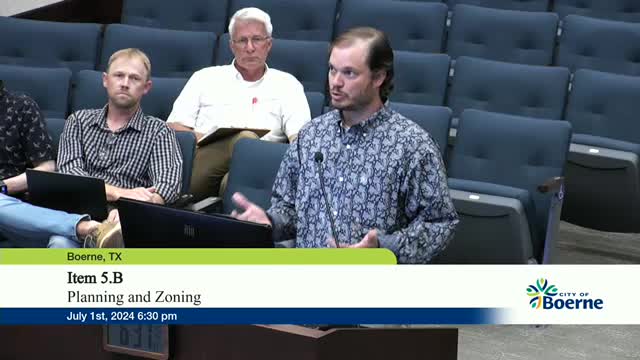Controversial floodplain variance sparks heated commission debate
July 01, 2024 | Boerne, Kendall County, Texas

This article was created by AI summarizing key points discussed. AI makes mistakes, so for full details and context, please refer to the video of the full meeting. Please report any errors so we can fix them. Report an error »

In a recent government meeting, discussions centered around a proposed replat application that seeks a variance related to floodplain regulations. The applicant, who owns a portion of two original lots, is attempting to consolidate these into a single parcel to maintain the existing number of lots while adhering to new drainage rules.
The proposal has sparked debate among commissioners, particularly regarding the implications of creating a second lot for residential development in a floodplain area. Commissioner Fryer expressed concerns about the size of the proposed second lot, which is significantly smaller than current floodplain guidelines allow. The applicant clarified that the intention behind the replat is not to increase the number of lots but to clean up the property’s title and potentially build a second home for personal use or rental.
Commissioners raised questions about the potential impact of granting the variance on the community's floodplain rating, which affects insurance rates for residents. It was noted that while variances can be granted under exceptional hardship, the criteria for such determinations are stringent. The applicant argued that the hardship stems from acquiring the property in its current fragmented state, which complicates development.
The meeting highlighted the balance between encouraging development in desirable areas and adhering to safety regulations designed to protect residents from flood risks. As the discussion unfolded, it became clear that the decision on this variance could set a precedent for future applications in similar floodplain situations, making it a critical point of consideration for the commission.
The proposal has sparked debate among commissioners, particularly regarding the implications of creating a second lot for residential development in a floodplain area. Commissioner Fryer expressed concerns about the size of the proposed second lot, which is significantly smaller than current floodplain guidelines allow. The applicant clarified that the intention behind the replat is not to increase the number of lots but to clean up the property’s title and potentially build a second home for personal use or rental.
Commissioners raised questions about the potential impact of granting the variance on the community's floodplain rating, which affects insurance rates for residents. It was noted that while variances can be granted under exceptional hardship, the criteria for such determinations are stringent. The applicant argued that the hardship stems from acquiring the property in its current fragmented state, which complicates development.
The meeting highlighted the balance between encouraging development in desirable areas and adhering to safety regulations designed to protect residents from flood risks. As the discussion unfolded, it became clear that the decision on this variance could set a precedent for future applications in similar floodplain situations, making it a critical point of consideration for the commission.
View full meeting
This article is based on a recent meeting—watch the full video and explore the complete transcript for deeper insights into the discussion.
View full meeting
